L13 Endocrine and Neuroendocrine Physiology
一、Introduction to Endocrine Principles
The Endocrine System
Important structures:
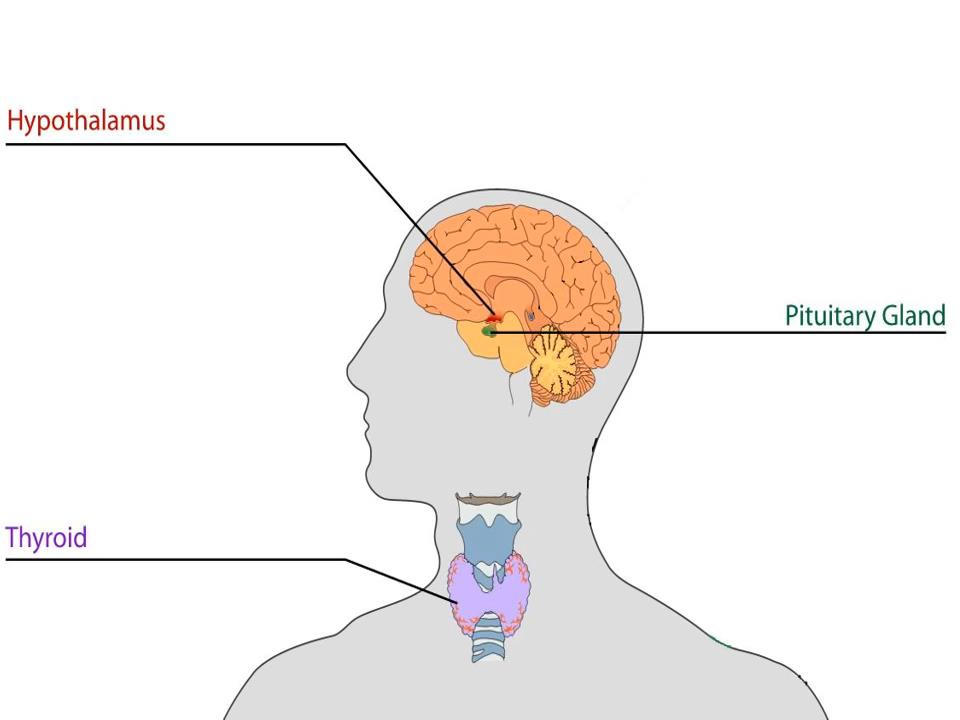
- Hypothalamus 下丘脑
- Pituitary gland 松果体
- Thyroid 甲状腺

Processes controlled by endocrine systems in both vertebrates and invertebrates include water balance, metabolism, coping with a hostile environment, reproduction, and growth and development.
脊椎动物和无脊椎动物的内分泌系统控制的过程包括水分平衡、新陈代谢、应对恶劣环境、繁殖、生长和发育。
A hormone is a chemical substance produced and released by nonneural endocrine cells or by neurons; it exerts regulatory influences on the function of other, distant cells reached via the blood; and it is effective at very low concentrations (as little as $10^{–12}$ M).
激素是由非神经内分泌细胞或神经元产生和释放的化学物质。 它对通过血液到达的其他远处细胞的功能产生调节作用。 并且在非常低的浓度(低至$10^{–12}$ M)下仍然有效。
Chemical signals act over short and long distances within the body
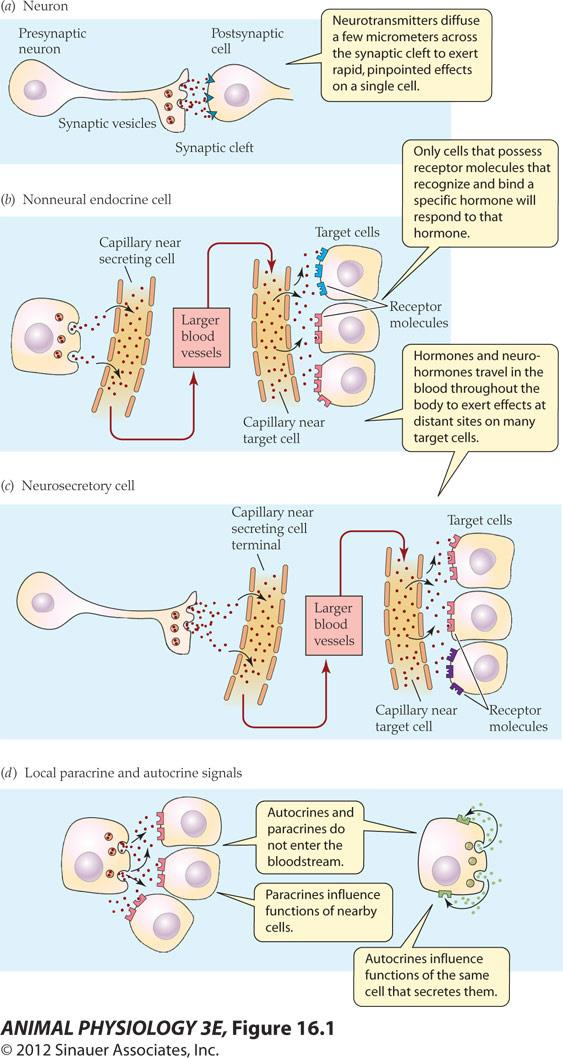
- Neurotransmitters diffuse a few micrometers across the synaptic cleft to exert rapid, pinpointed effects on a single cell
- Hormones and neuro hormones travel in the blood throughout the body to exert effects at distant sites on many target cells.
- Autocrines and paracrine do not enter the bloodstream
- Autocrines influence functions of the same cell that secretes them
- Paracrines influence functions of nearby cells
1. Concentrations of hormones in the blood vary
The blood concentration of a hormone represents a balance between the rate of addition of hormone to the blood (by secretion) and the rate of removal of hormone from the blood (by metabolic destruction and excretion).
- Hormone concentration depends primarily on the rate of addition to the blood, because the rate of removal is relatively constant.
A hormone’s half-life—the time required to reduce the concentration by one-half—indicates its rate of removal from the blood and thus the duration of its activity
2. Most hormones fall into three chemical classes
Three types of hormones (chemical classes):
- Steroid hormones 类固醇激素
- Steroid hormones: made from cholesterol, lipid-soluble and can move across the membrane; made by the gonads, adrenal cortex, the skin and the placenta.
- Peptide and protein hormones 肽和蛋白质类激素
- Peptide and protein hormones: such as antidiuretic(抗利尿剂)hormones, insulin and growth hormones; soluble in aqueous solutions.
- Amine hormones 胺类激素
- Amine hormones : modified amino acids, such as melatonin
Hormone molecules exert their effects by producing biochemical changes in target cells
- Lipid-soluble hormones (steroids and iodothyronines) bind to intracellular receptors. Because they are lipid-soluble, these hormones enter target cells by diffusing through the lipid bilayer of the cell membrane or carried bound to a lipoprotein molecule. Their receptors are located either in the cytoplasm or in the nucleus
Steroid hormones are derived from cholesterol
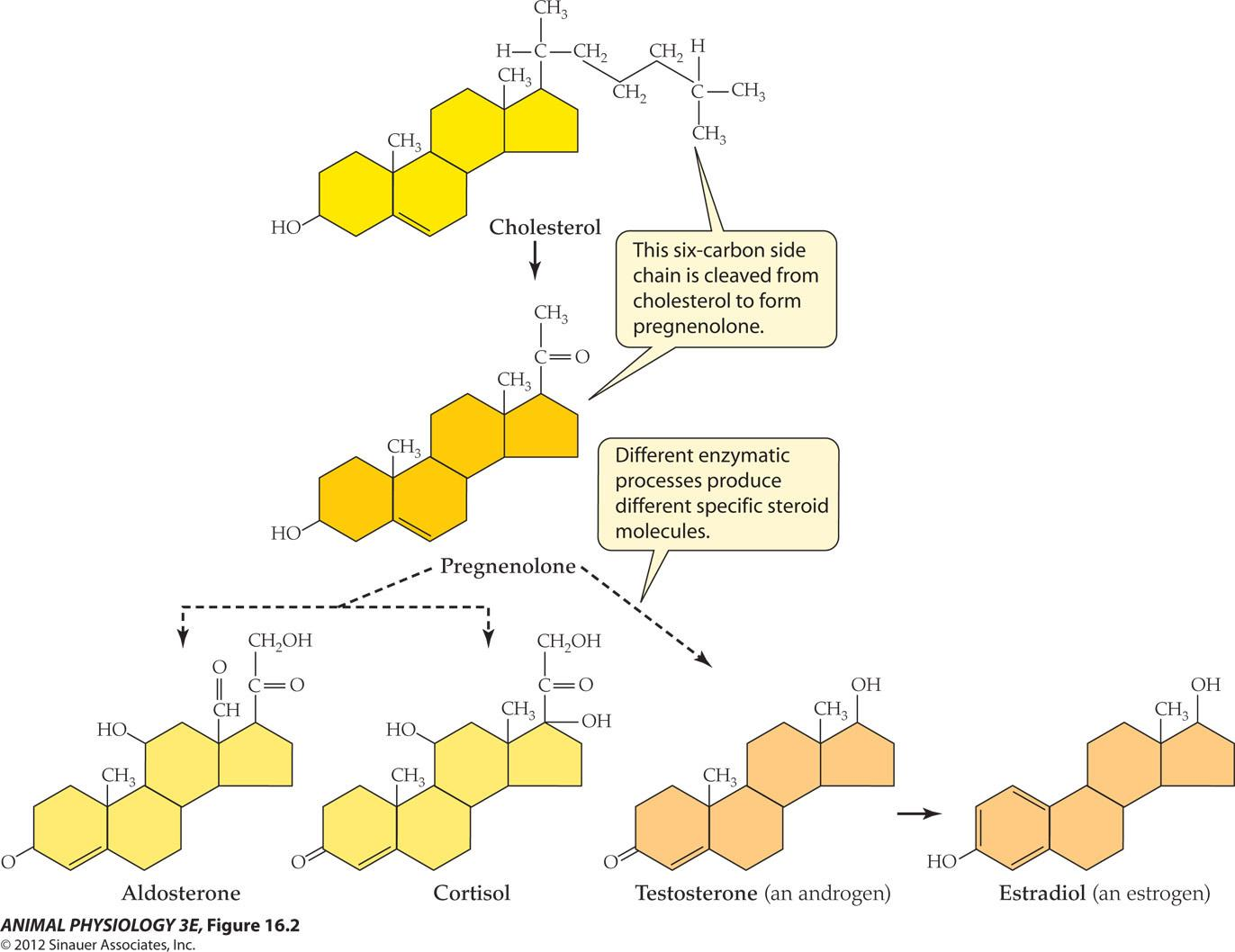
- Steroidogenesis begins with the formation of pregnenolone. Different steroid-secreting cells possess different enzymes that modify pregnenolone to produce specific steroid hormones.
- The six-carbon side chain is cleaved from cholesterol to form pregnenolone.
- Different enzymatic processes produce different specific steroid molecules
In vertebrates, they include antidiuretic hormones, insulin, and growth hormone.
- 抗利尿激素, 胰岛素, 生长激素

Peptide and protein hormones consist of assemblages of amino acids
- Mammalian GnRH is a decapeptide (10 amino acids)
- Gonadotropin-releasing hormone (GnRH,促性腺激素释放激素)
- Human insulin consists of two chains of amino acids connected and stabilized by disulfide bridges
Amine hormones are derived from modified amino acids
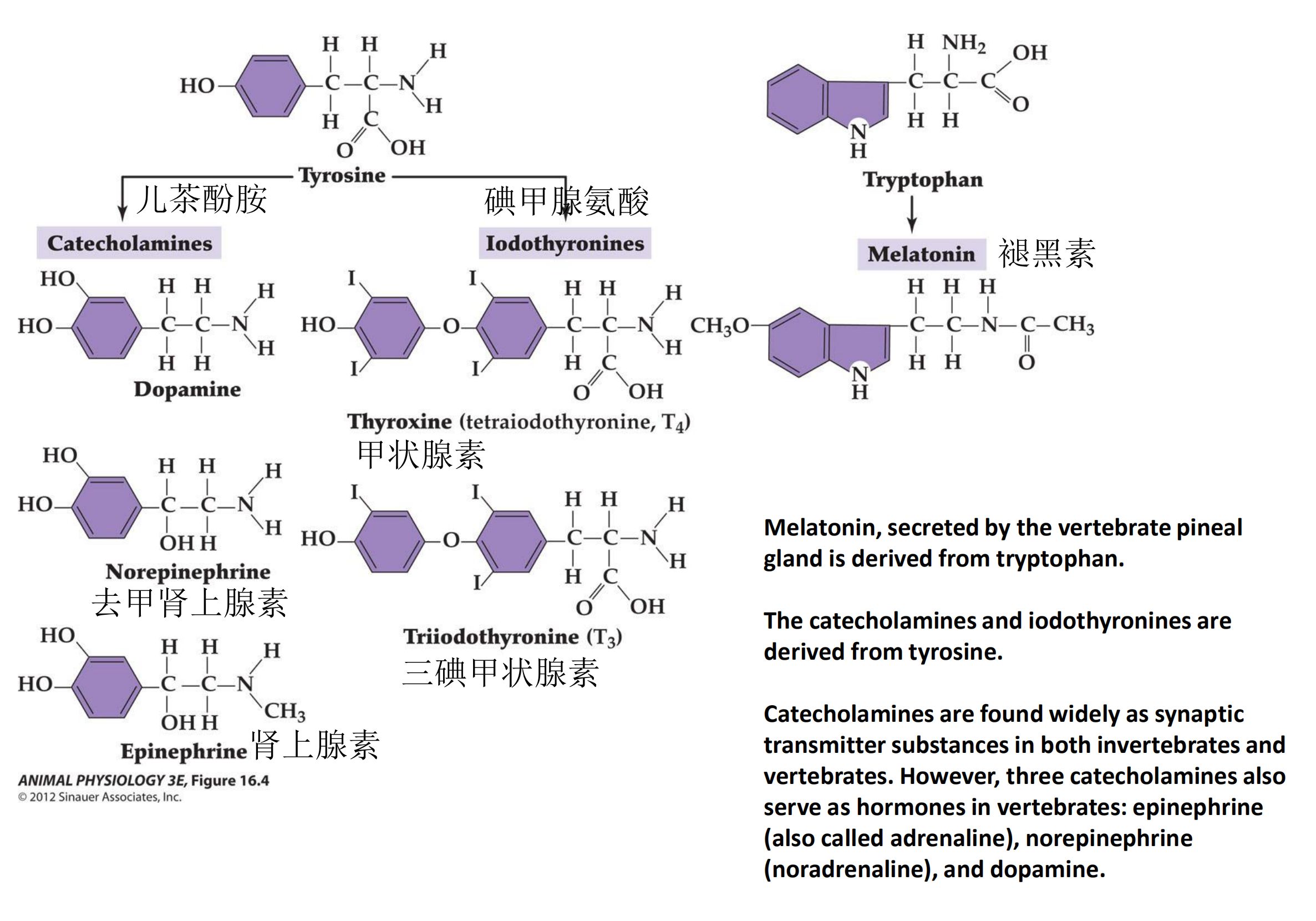
- Melatonin, secreted by the vertebrate pineal gland is derived from tryptophan.
- The catecholamines(儿茶酚胺) and iodothyronines (碘甲状腺原氨酸) are derived from tyrosine
- Catecholamines are found widely as synaptic transmitter substances in both invertebrates and vertebrates. However, three catecholamines also serve as hormones in vertebrates: epinephrine (also called adrenaline), norepinephrine (noradrenaline), and dopamine.
二、Synthesis, Storage, and Release of Hormones
Synthesis
1. Peptide hormones: Insulin
Insulin is synthesized, processed, and packaged like other peptide proteins

- A signal sequence(the P segment)directs the preprohormone molecule into the lumen of the rough ER Enzymes in the ER cleave the P segment to produce proinsulin
- The proinsulin moves through the ER, via shuttle vesicles, and into the Golgi apparatus.
- In the Golgi apparatus, three disulfide bridges fold the proinsulin molecule
- The Golgi apparatus buds off vesicles that contain proinsulin and enzymes
- The enzymes cleave the C segment from proinsulin to form mature insulin
- Insulin and C segments are stored in vesicles awaiting release.
- Depolarization of the cell membrane triggers release by exocytosis
Peptide hormones are synthesized at ribosomes, stored in vesicles, and secreted on demand.
2. Steroid hormones
Steroid hormones are synthesized on demand prior to secretion, and are released into the blood by diffusion.
三、Control of endocrine secretion the vertebrate pituitary gland
The pituitary gland 脑下垂体

The pituitary gland lies immediately below the hypothalamus and consists of two parts: the adenohypophysis, commonly called the anterior pituitary, and the neurohypophysis, commonly called the posterior pituitary.
1. Organization

2. Posterior pituitary
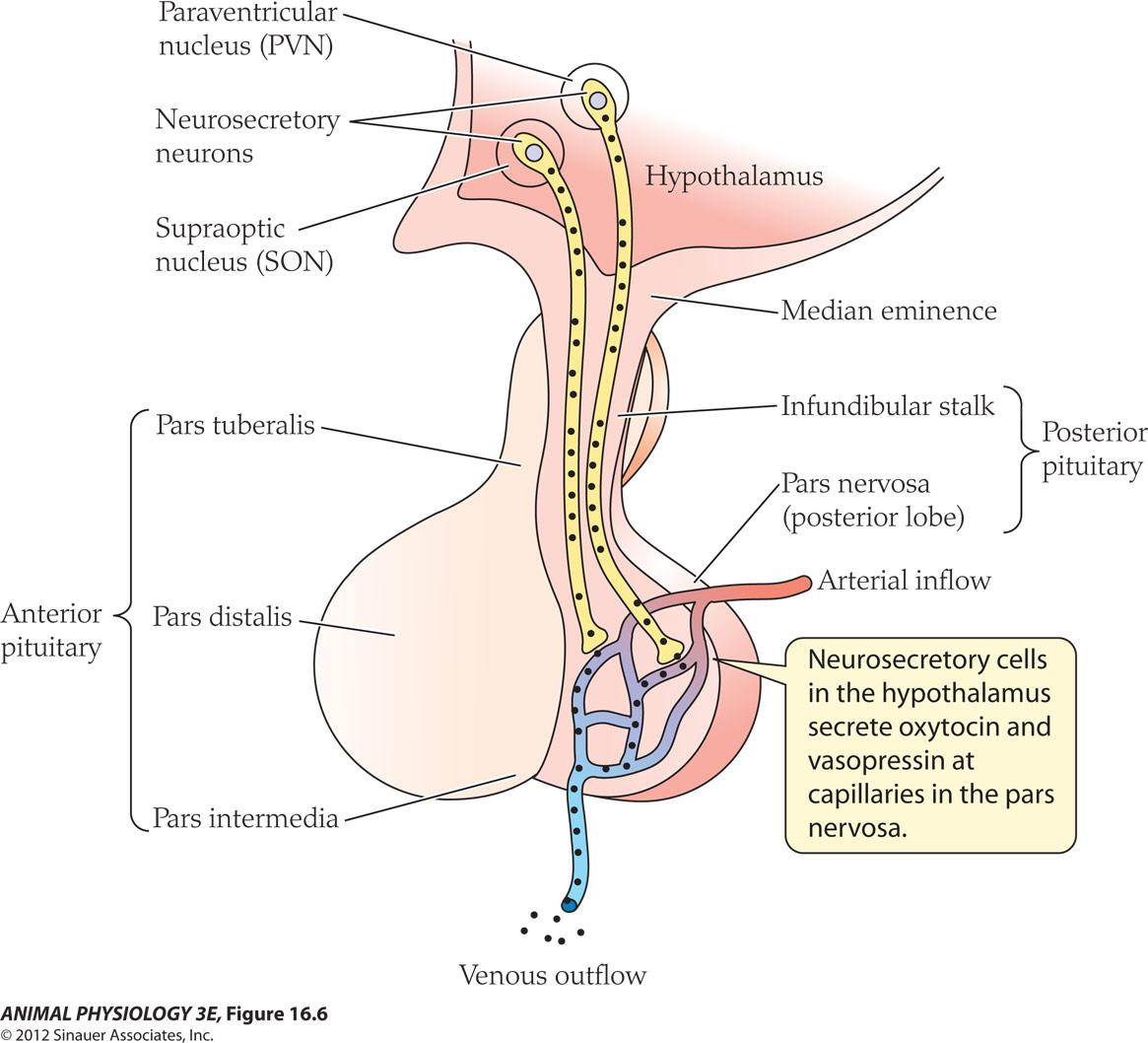
Paraventricular Nucleus (PVN): Two clusters of neuronal Cell bodies in the hypothalamus To produce the two hormones
Infundibular stalk: 漏斗柄; 漏斗干
Adenohypophysis: 脑下垂体前叶
Neurohypophysis: 脑下垂体后叶
Neurosecretory cells in the hypothalamus secrete oxytocin and vasopressin at capillaries in the pars nervosa
Axons terminate at a rich Network of capillaries. Two hormones are secreted:
Vasopressin (ADH)
Oxytocin
Neurohypophysis 脑下垂体后叶
(1) Vasopressin
Vasopressin: also called antidiuretic hormone (ADH), 抗利尿激素
- Regulates blood volume and osmotic concentration
- Oxytocin: (produced in both males and females) to cause contraction of uterus during birth and ejection of milk by the mammary glands during suckling
(2) Oxytocin
Structure of Oxytocin
Oxytocin - the Bonding Hormone
- is a mammalian neurohypophysial hormone, (secreted by the posterior pituitary gland), that acts primarily as a neuromodulator in the brain
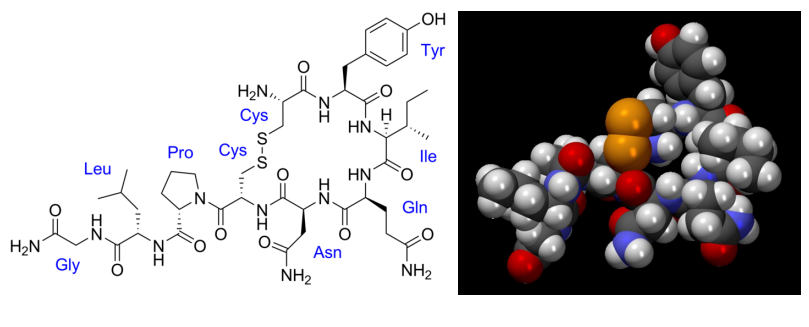
- Oxytocin is a peptide of nine amino acids. Its systematic name is cysteine-tyrosine-isoleucine-glutamine-asparagine-cysteine-proline-leucine-glycine-amide (cys – tyr – ile – gln – asn – cys – pro – leu – gly – NH2, or CYIQNCPLG-NH2). Oxytocin has a molecular mass of 1007 daltons.
Studying the social interactions of prairie voles has led scientists to believe that oxytocin plays an important role in mediating social bonds.
Actions of Oxytocin
Actions within the Brain
- Bonding
- Romantic attachment
- Sexual arousal
- Maternal behavior (lactation)
- Drug interactions (reduce the development of tolerance to certain addictive drugs)
Oxytocin as a Drug
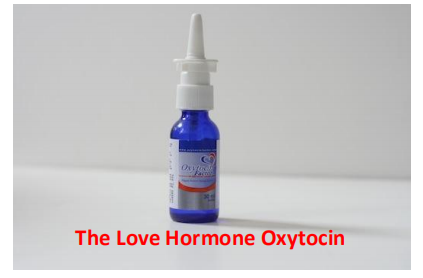
Recent studies have begun to investigate oxytocin’s role in various behaviors including orgasm, social recognition, pair bonding, anxiety, and maternal behaviors For this reason, it is sometimes referred to as the”bonding hormone
科学家探索催产素对孤独症与精神分裂症中社会功能缺陷的治疗作用
- Scientists Probe Oxytocin Therapy for Social Deficits in Autism, Schizophrenia
(3) Posterior pituitary nonapeptides found in vertebrates
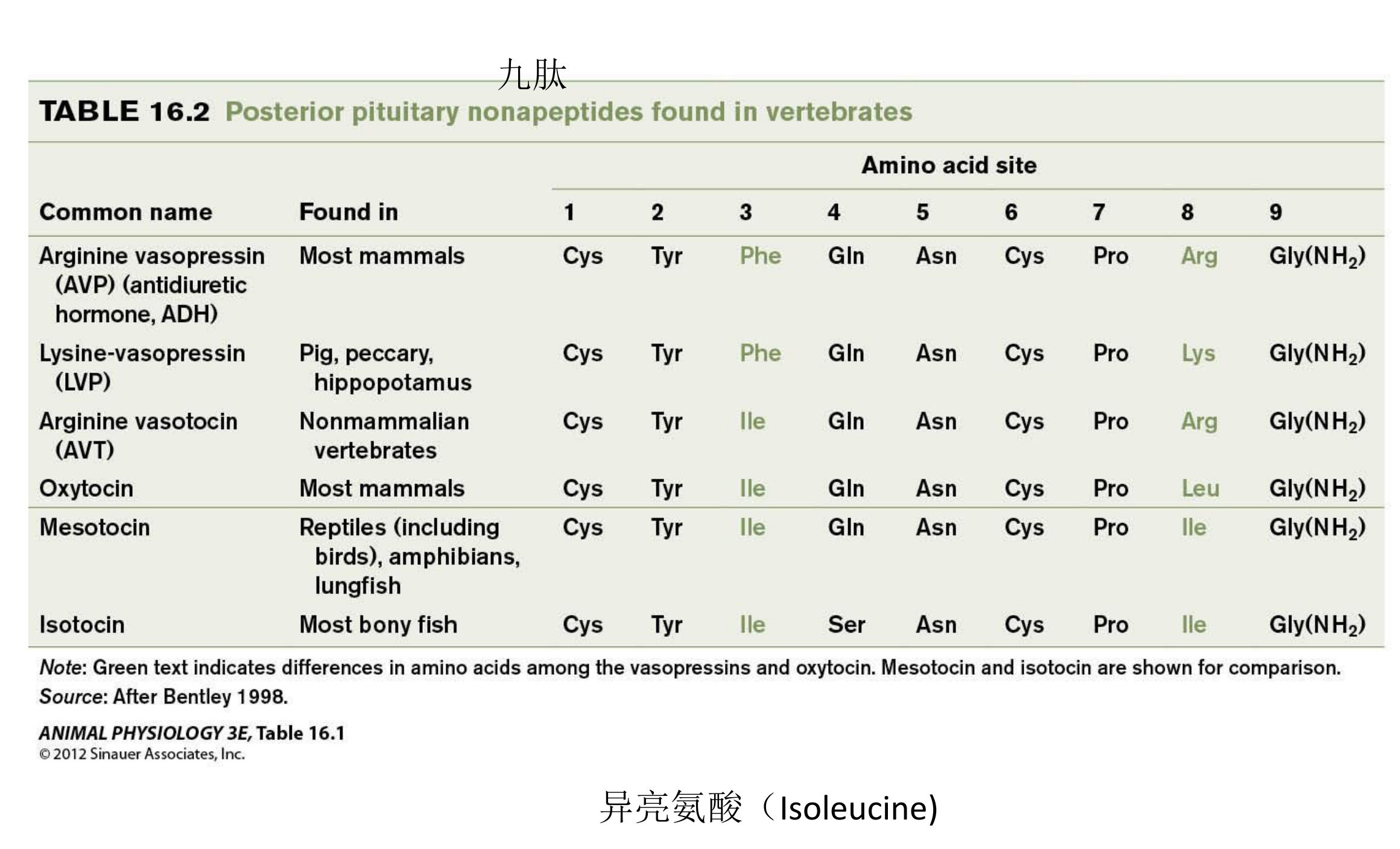
Anterior pituitary and hypothalamus
The anterior pituitary and hypothalamus – to illustrate neurosecretary control of endocrine cells
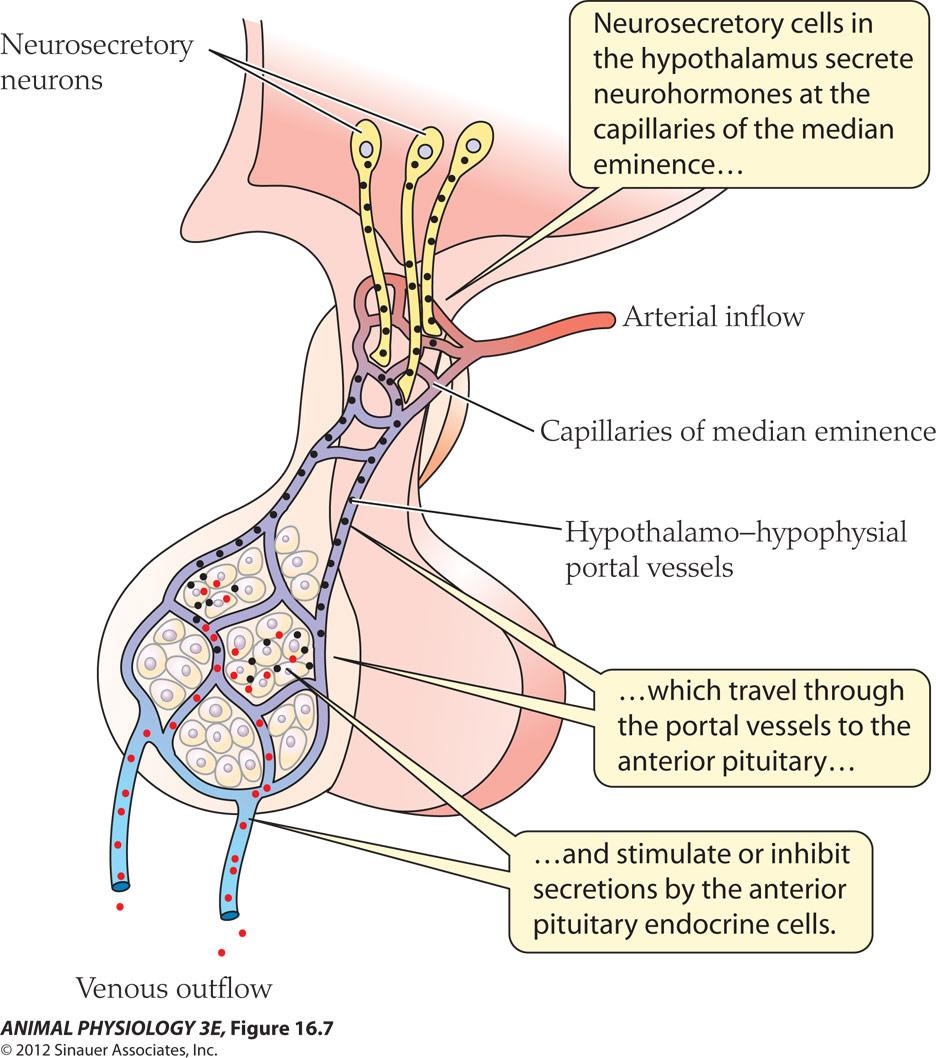
- Neurosecretory cells in the hypothalamus secrete neurohormones at the capillaries of the median eminence which travel through the portal vessels to the anterior pituitary, and stimulate or inhibit secretions by the anterior pituitary endocrine cells
Anterior pituitary hormones are made in the endocrine cells within its tissue.
- All are peptides
Anterior pituitary hormones are categorized according to their target tissues:
- to exert their principal effects on Non-endocrine tissue (growth hormone, Prolactin and melanocyte-stimulating hormone)
- hormones control other endocrine glands (thyroid-stimulating hormone = thyrotropins) Without input from its tropic hormone, the Gland will stop secreting hormones and shrink
(1) The anterior pituitary hormones
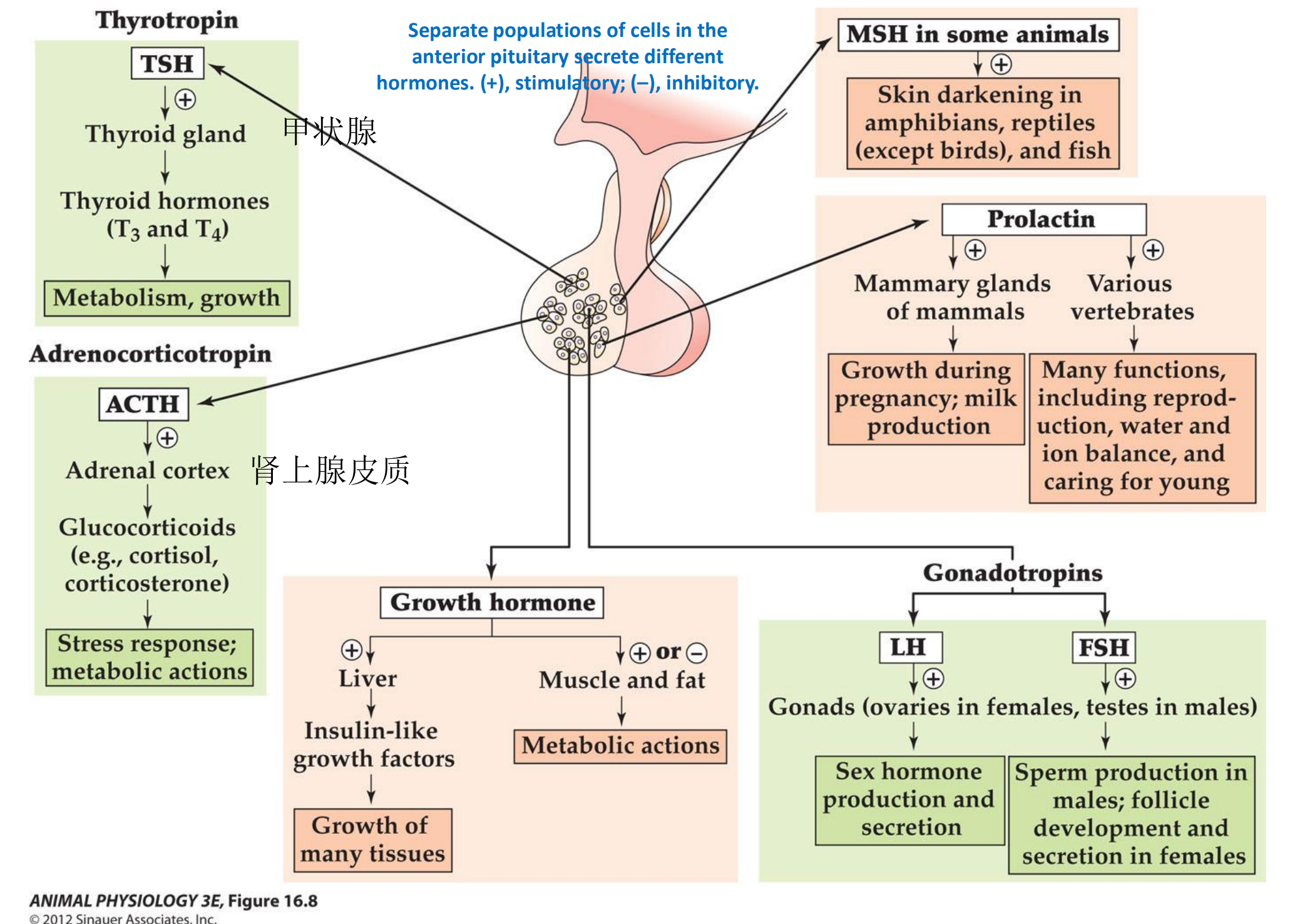
- Separate populations of cells in the anterior pituitary secrete different hormones. (+), stimulatory; (–), inhibitory.
- Thyrotropin:
- Secrete the TSH
- Stimulate the Thyroid gland
- Release Thyroid hormones (T3 and T4)
- Regulate metabolism and growth
- Adrenocorticotropin:
- Secrete ACTH
- Stimulate Adrenal cortex
- Release Glucocorticoids
- Regulate the stress response and metabolic actions
- MSH:
- Stimulate skin darkening in amphibians, reptiles (except birds), and fish
- Prolactin:
- Simulate the mammary glands of mammals, therefore regulate growth during pregnancy; milk production
- In various vertebrates. stimulate many functions including reproduction, water and ion balance and caring for young
- Growth hormone:
- Stimulates the liver:
- Release Insulin-like growth factors
- Regulate growth of many tissues
- Stimulate or inhibit muscle and fat tissue, therefore regulate metabolic rate.
- Stimulates the liver:
- Gonadotropins:
- Release LH and FSH
- Stimulate gonads (ovaries in females, testes in males)
- LH: Sex hormone production and secretion
- FSH: Regulate sperm production in males: follicle development and secretion in females
(2) What kind of signals control the secretion of the anterior pituitary gland?
Neurohormones secreted by neurosecretary cells in the hypothalamus. The anterior pituitary and the hypothalamus are connected by a specific dedicated vascular pathway – hypothalamo-hypophysial portal vessels.
Hypothalamic neurosecretory cells produce neurohormones that control the secretion of specific groups of anterior pituitary cells. Some are releasing hormones (RH), some are inhibiting hormones (IH)
Hormones and neural input modulate endocrine control pathways
- AXIS hormones and neural input modulate endocrine control pathways
- One endocrine secretion act on another in a sequence is a system called axis. Such as the hypothalamus-anterior pituitary-thyroid axis that mediates secretion of thyroid hormones
- Another example is the HPA: hypothalamus-pituitary-adrenal cortex . WE are using this as an example to illustrate how rates of endocrine secretion can be modulated.
(3) The adrenal gland
Structure
The adrenal gland consists of an inner medulla and an outer cortex
HPA: hypothalamus-pituitary-adrenal cortex
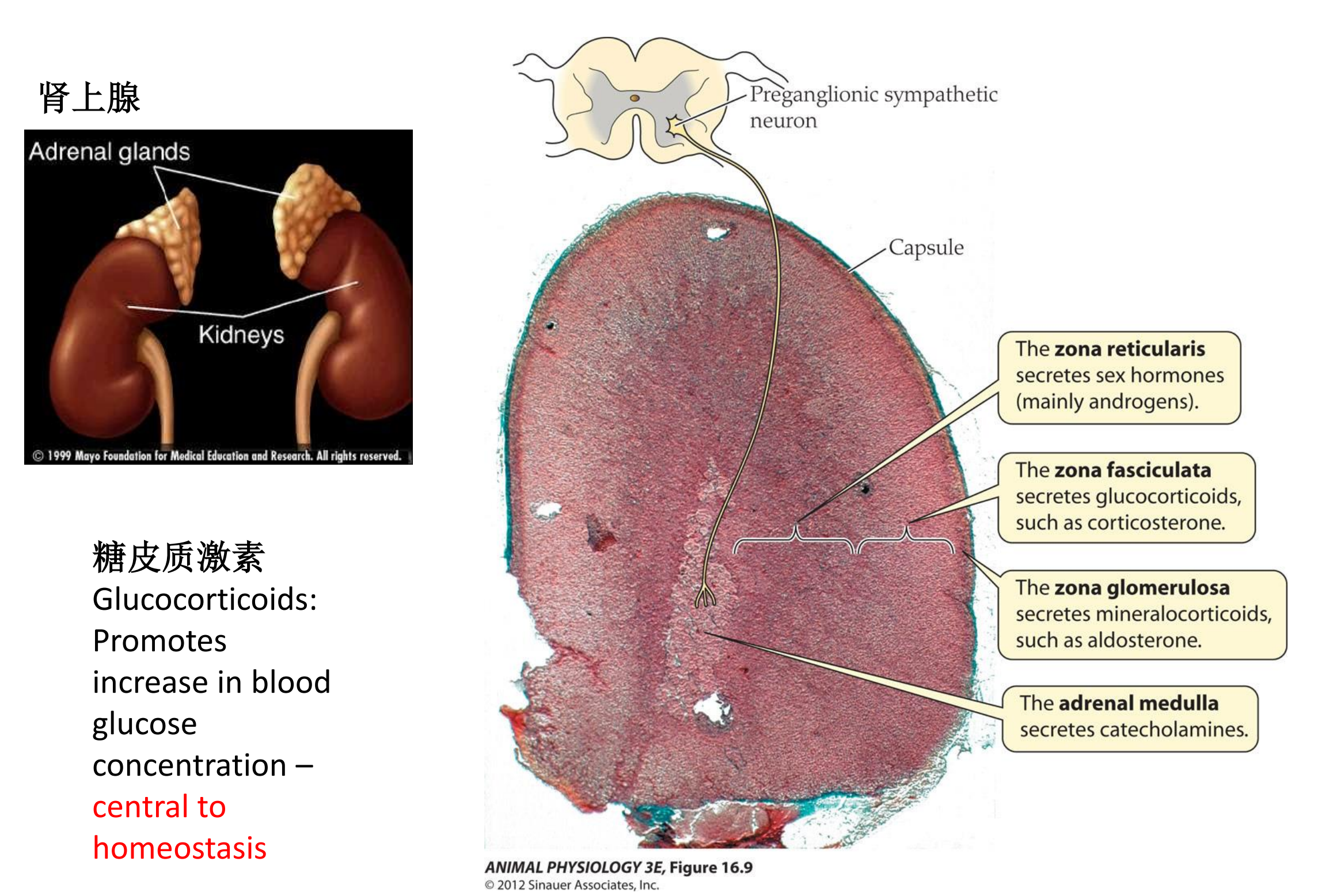
- The zona reticularis(网状带) secretes sex hormones (mainly androgens(雄激素))
- The zona fasciculata(束状带) secretes glucocorticoids(糖皮质激素), such as corticosterone(皮质甾酮,皮质酮)
- The zona glomerulosa(肾小球带) secretes mineralocorticoids(盐皮质激素) such as aldosterone(醛固酮)
- The adrenal medulla(肾上腺髓质) secretes catecholamines (儿茶酚胺)
糖皮质激素
- Glucocorticoids: Promotes increase in blood glucose concentration – central to homeostasis
Glucocorticoid secretion is controlled by the HPA axis
- HPA: hypothalamus-pituitary-adrenal cortex
- Glucocorticoids (cortisone, cortisol, and corticosterone), a class of steroid hormones so named because (among other functions) they promote an increase in the blood concentration of glucose (“gluco”) and because they are secreted by the adrenal cortex (“cortico”). Glucocorticoids are central to homeostasis. Their widespread effects include ensuring adequate blood glucose levels, maintaining the responsiveness of blood vessels to stimulation by catecholamines, and limiting inflammation.
Hormonal, neural, and feedback mechanisms modulate the action of the HPA axis

- CRH = corticotropin-releasing Hormone
- ACTH = adreno-Corticotropic hormone
- Neural imput:
- Neurons generate bursts of action potentials that produce pulsatile secretions
- Stress increases CRH secretion
- The circadian clock sets the daily rhythm of CRH secretion
- Glucocorticoids in the general circulation exert negative feedback on the hypothalamus and anterior pituitary.
Process:
- Neural input
- Hypothalamic neurosecretory cells secrete CRH
- Anterior pituitary corticotrophs secrete ACTH
- Adrenal cortex zona fasciculata cells secrete glucocorticoids
- Many target tissues
Protein catabolism in muscle and bone
Gluconeogenesis in liver
Fat catabolism in adipose tissue
Decreased immune system functions
Hormone Interaction
A hormone can influence the effects of another hormone at the same target by three ways:
- Synergism (协同作用,producing an enhanced response)
- Permissiveness (the presence of one hormone is required for the other to exert the effect)
- Antagonism (拮抗作用,one hormone opposes the action of another)
1. Example1: Interactions of insulin, glucagon, and epinephrine illustrate synergism and antagonism
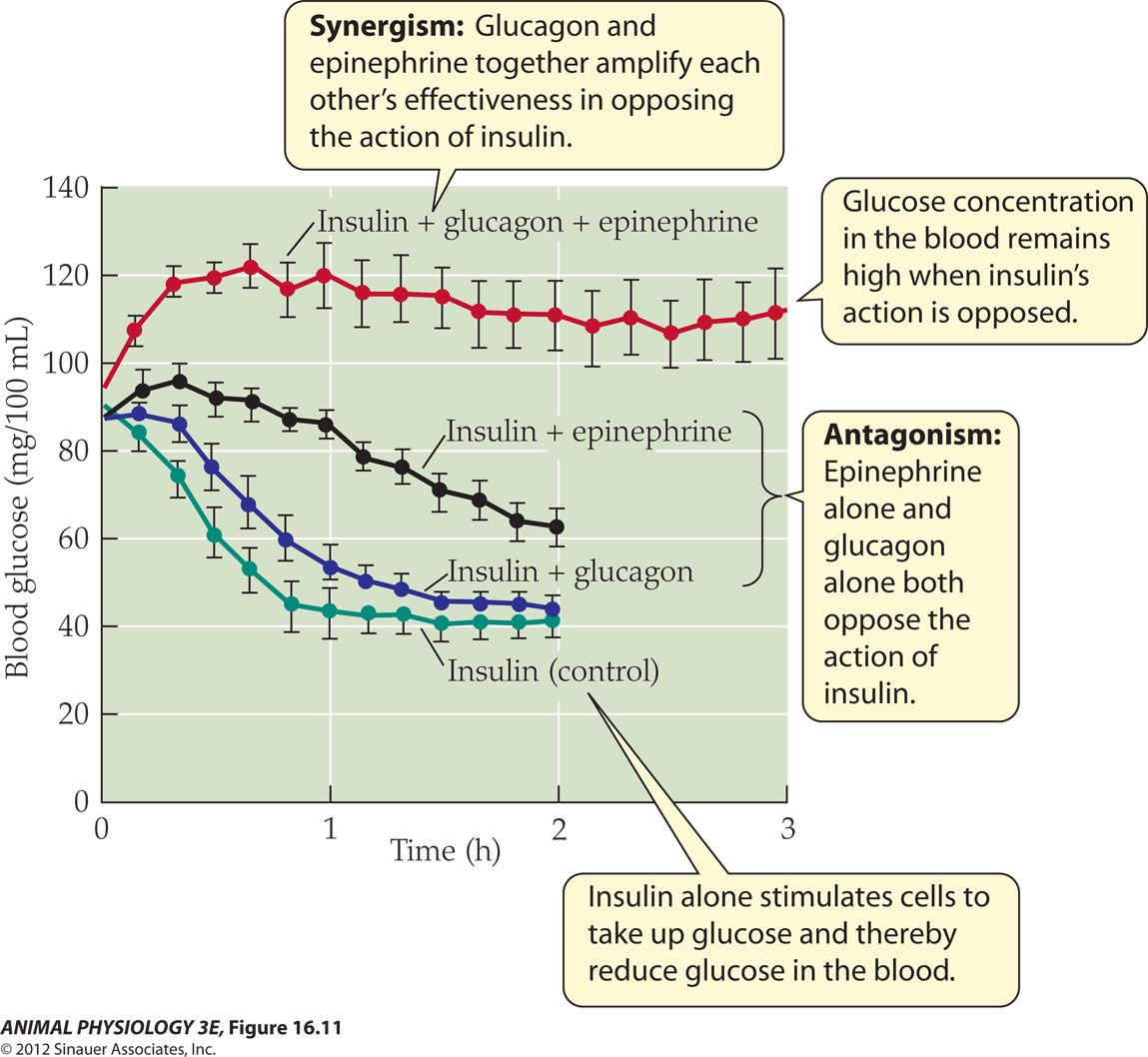
- Synergism: Glucagon and epinephrine together amplify each others effectiveness in opposing he action of insulin
- Glucose concentration in the blood remains high when insulins action is opposed
- Antagonism: Epinephrine alone and glucagon alone both oppose the action of Insulin
- Insulin alone stimulates cells to take up glucose and thereby reduce glucose in the blood
四、The Mammalian Stress Response AXIS-hormones and neural input modulate endocrine control pathways
The sympathetic nervous system and the HPA axis
The mammalian stress response includes activation of both the sympathetic nervous system and the HPA axis
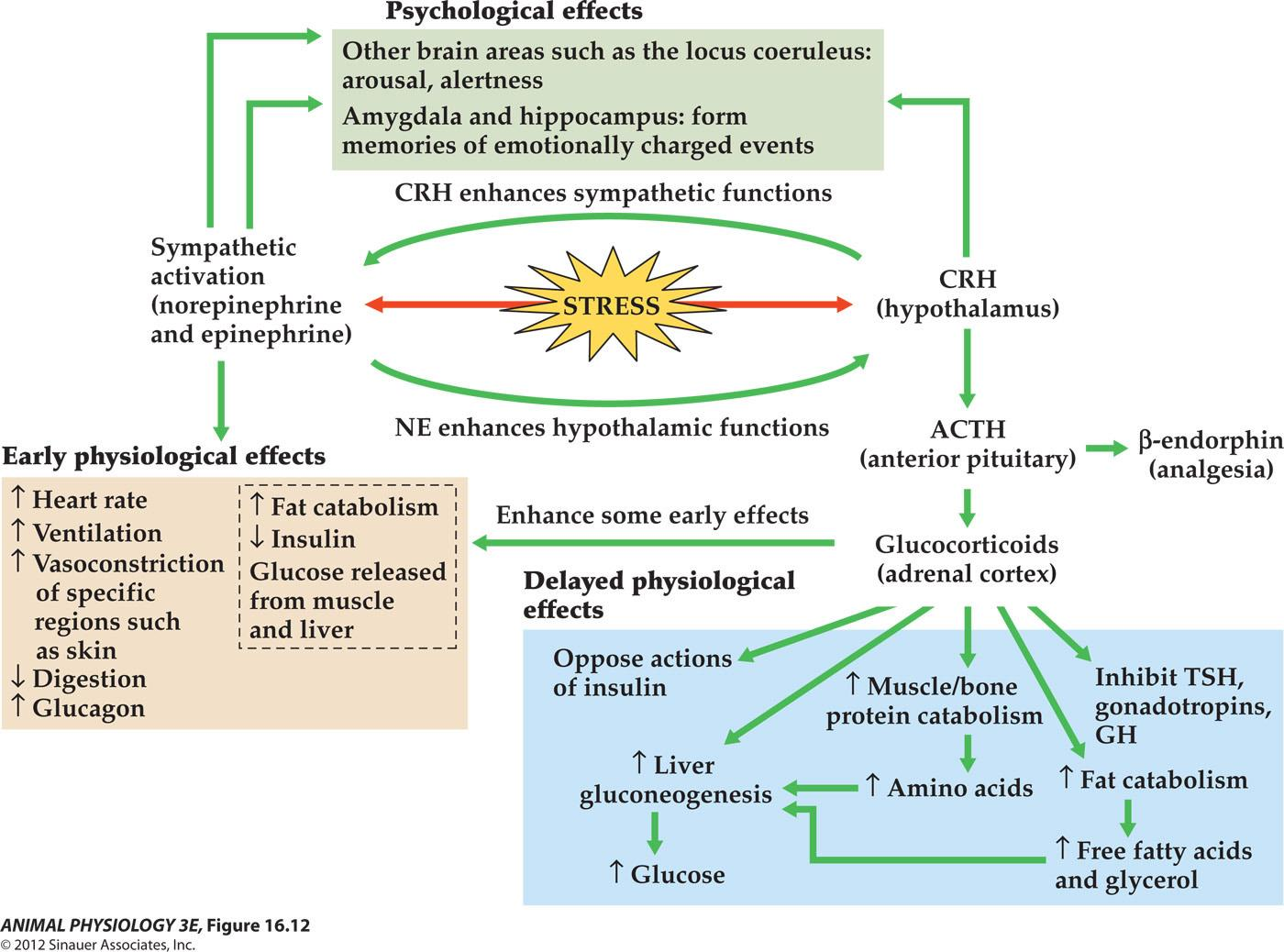
The central nervous system and the immune system
The central nervous system and the immune system interact during the stress response
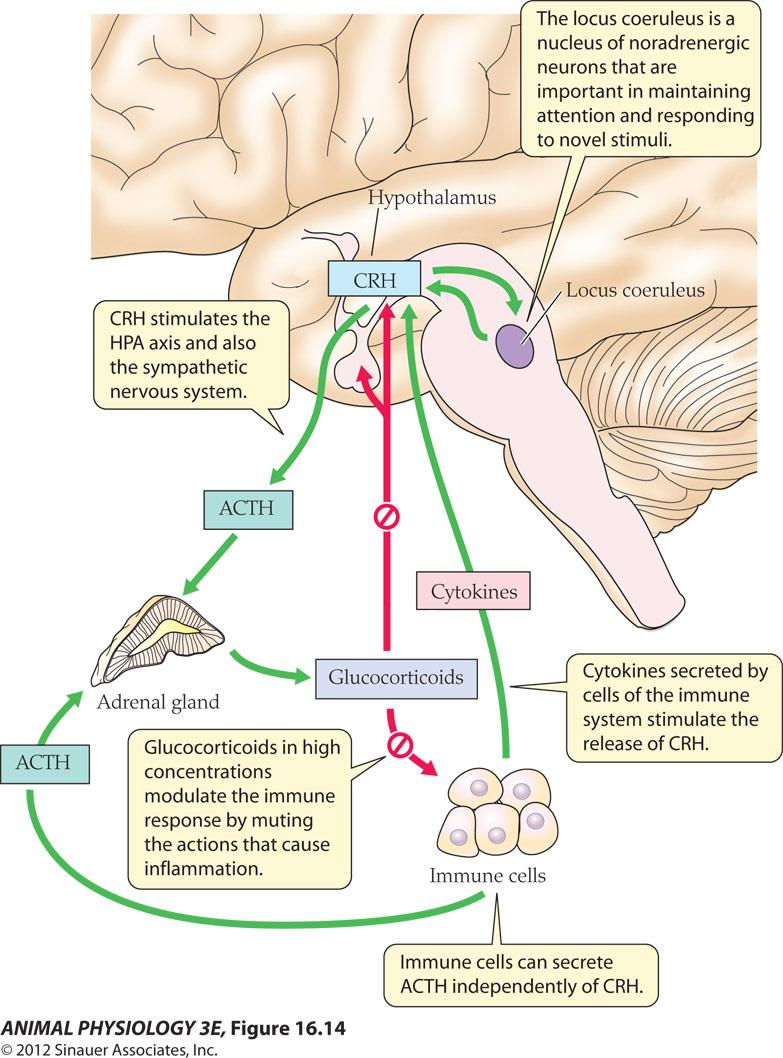
- The locus coeruleus is a nucleus of noradrenergic neurons that are Important in maintaining attention and responding to novel stimuli
- CRH stimulates the HPA axis and also the sympathetic nervous system
- Cytokines secreted by cells of the immune system stimulate the release of CRH
- Glucocorticoids in high concentrations modulate the immune response by muting the actions that cause inflammation
- Immune cells can secrete ACTH independently of CRH
五、Endocrine Control of Salt and Water Balance in Vertebrates
The regulation of blood volume after blood loss
If an animal experiences a severe wound and loses blood, several mechanisms are called into play to correct the loss of blood volume

Blood volume directly affects blood pressure, and blood pressure is necessary to ensure adequate delivery of oxygen and nutrients to the brain and other essential organs.
- Catecholamines released by the already activated sympathetic nervous system stimulate the heart and blood vessels to maintain blood pressure.
- Vasopressin released from the posterior pituitary stimulates the nephrons in the kidney to retain water, and aldosterone secreted by cells in the zona glomerulosa of the adrenal cortex acts at the nephrons to retain sodium, which exerts an osmotic holding effect on water.
The combined actions of these hormones are aimed at conserving fluid volume, which translates to adequate blood volume and blood pressure.
Antidiuretic hormones (ADH) conserve water
ADH is a nonapeptide produced by neuroendocrine cell bodies in the hypothalamus and released from their axon terminals in the posterior pituitary gland
This hormone acts to conserve water by preventing the production of a large volume of urine
All major classes of vertebrates produce hormones with antidiuretic action. Most mammals use arginine vasopressin (AVP), but some pigs and their relatives use lysine vasopressin (LVP), and nonmammalian vertebrates use the closely related arginine vasotocin (AVT)
In all vertebrates, the target tissue of these hormones is the nephron of the kidney. Antidiuretic hormones stimulate the reabsorption of water from the lumen of the nephron.
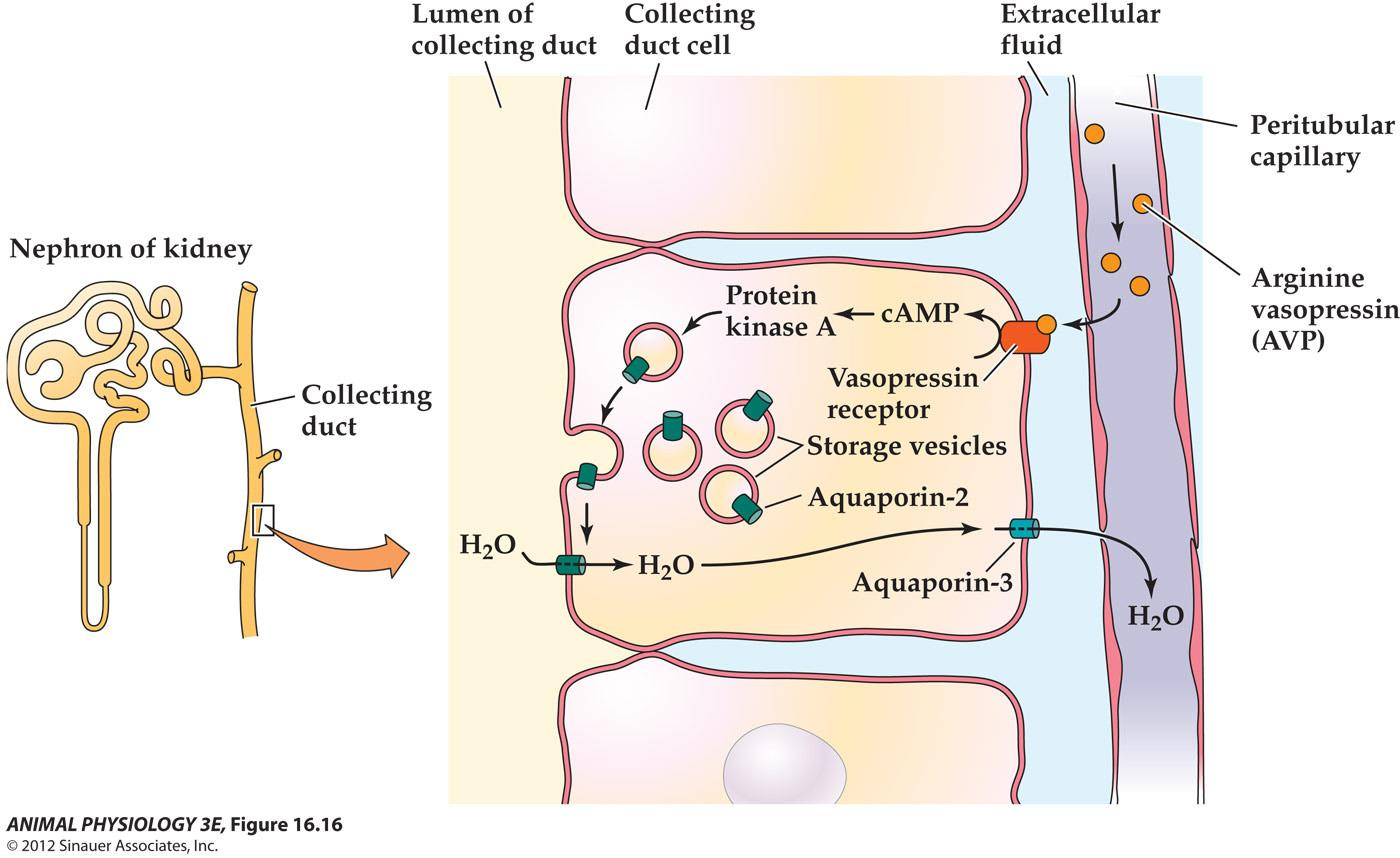
- AVP binds to its receptor.
- A second messenger system acts to shuttle storage vesicles to the membrane
- Storage vesicles fuse with the apical membrane to incorporate AQP-2 channels
- Water follows its osmotic gradient through AQP-2 channels into the epithelial cells
- and into the extracellular fluid through permanent aquaporins.
- Water moves from the extracellular fluid into the blood through spaces between capillary endothelial cells
The renin–angiotensin–aldosterone system conserves sodium
Aldosterone is a steroid hormone (see Figure 16.2) produced and secreted by the zona glomerulosa of the adrenal cortex. It is called a mineralocorticoid because it contributes to the balance of minerals—mainly sodium and potassium—in the body
The main target tissues of aldosterone are epithelial cells located in the late distal tubule and early collecting duct of the nephron
- The effect of aldosterone is to increase the ability of these cells to reabsorb Na+ (take it out of the lumen and return it to the interstitial fluid and plasma)
The renin–angiotensin–aldosterone system corrects low extracellular fluid volume and low blood pressure
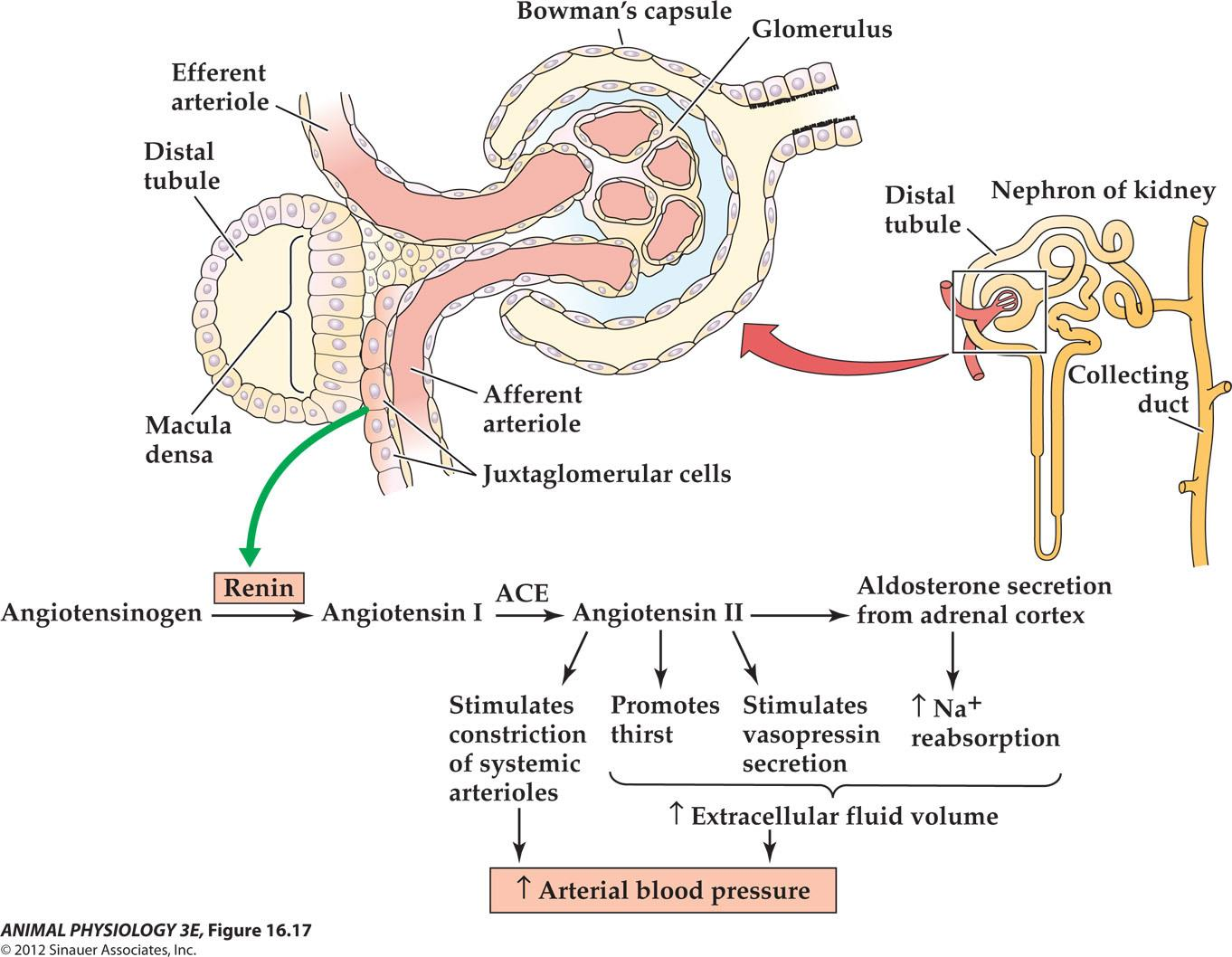
- ACE: angiotensin-converting enzyme
SUMMARY
Endocrine Control of Salt and Water Balance in Vertebrates
- Hormones continuously regulate the balance of salt and water in vertebrates
- Vasopressins are peptide neurohormones that stimulate the conservation of water
- Aldosterone is a steroid hormone that stimulates the conservation of Na+. It is part of the renin–angiotensin–aldosterone system that is set in motion under conditions of low arterial blood pressures
六、Endocrine Control of Nutrient Metabolism in Mammals – insulin
The action of insulin
Insulin regulates short-term changes in nutrient availability
- The only hormone can lower blood glucose level
Many mammals go through bouts of feeding separated by several hours of not feeding. To prevent alternations of feast and famine at the cellular level, mechanisms are set in motion that favor storage of nutrient molecules immediately after a meal and mobilization of nutrients from storage depots as the hours pass until the next meal. Insulin is the most important hormone involved in managing short-term fluctuations of nutrient availability
Because insulin causes a decrease in blood glucose levels, it is said to exert a hypoglycemic effects
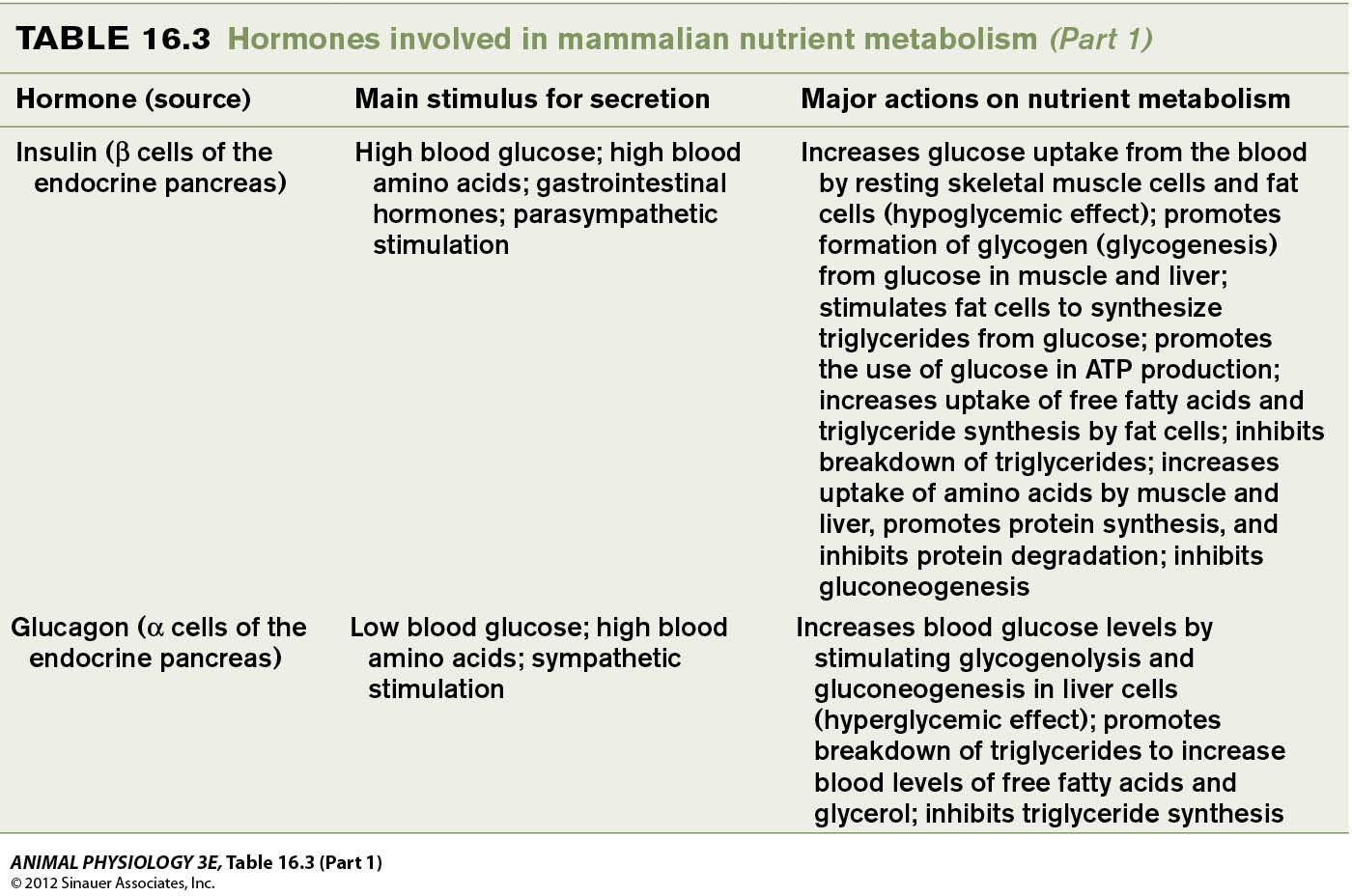
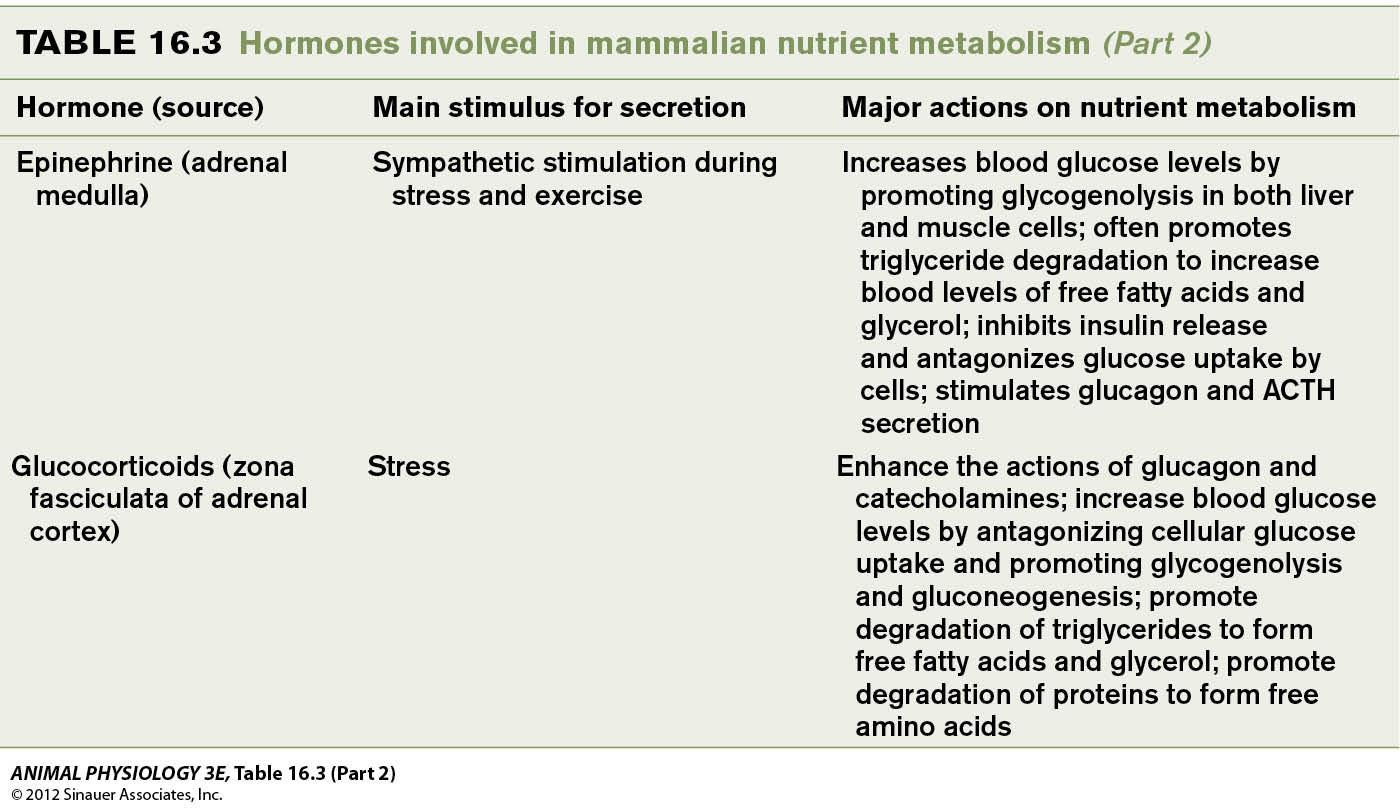
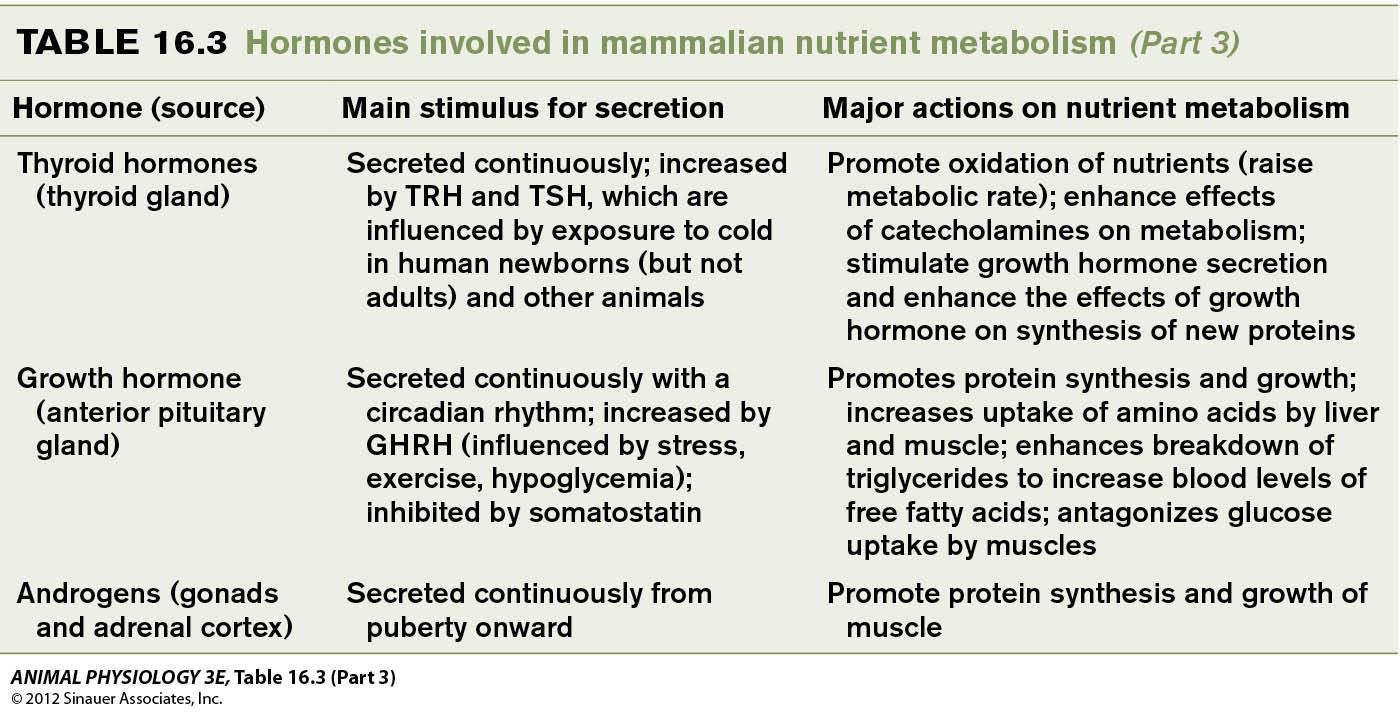
| Hormone (source) | Main stimulus for secretion | Major actions on nutrient metabolism |
|---|---|---|
| Insulin (β cells of the endocrine pancreas) | High blood glucose; high blood amino acids; gastrointestinal hormones; parasympathetic stimulation |
1. Increases glucose uptake from the blood by resting skeletal muscle cells and fat cells (hypoglycemic effect); 2. promotes formation of glycogen (glycogenesis) rom glucose in muscle and liver stimulates fat cells to synthesize triglycerides from glucose; promotes the use of glucose in ATP production; 3. increases uptake of free fatty acids and triglyceride synthesis by fat cells; inhibits breakdown of triglycerides; 4. increases uptake of amino acids by muscle and liver, promotes protein synthesis, and inhibits protein degradation; 5. inhibits gluconeogenesis |
| Glucagon (α cells of the endocrine pancreas | Low blood glucose; high blood amino acids; sympathetic stimulation |
1. Increases blood glucose levels by stimulating glycogenolysis and gluconeogenesis in liver cells hyperglycemic effect) 2. promotes breakdown of triglycerides to increase blood levels of free fatty acids and glycerol; 3. inhibits triglyceride synthesis |
| Epinephrine (adrenal medulla | Sympathetic stimulation during stress and exercise | 1. Increases blood glucose levels by promoting glycogenolysis in both liver and muscle cells; 2. often promotes triglyceride degradation to increase blood levels of free fatty acids and glycerol; 3. inhibits insulin release and antagonizes glucose uptake by cells; 4. stimulates glucagon and ACTH secretion |
| Glucocorticoids ( zona fasciculata of adrenal cortex) | Stress | 1. Enhance the actions of glucagon and catecholamines; 2. increase blood glucose levels by antagonizing cellular glucose uptake and promoting glycogenolysis and gluconeogenesis; 3. promote degradation of triglycerides to form free fatty acids and glycerol; 4. promote degradation of proteins to form free amino acids |
| Thyroid hormones ( thyroid gland) | Secreted continuously; increased by TRH and TSH, which are influenced by exposure to cold in human newborns (but not adults )and other animals |
Promote oxidation of nutrients(raise metabolic rate ): enhance effects of catecholamines on metabolism: stimulate growth hormone secretion and enhance the effects of growth normone on synthesis of new proteins |
| Growth hormone (anterior pituitary gland | Secreted continuously with a circadian rhythm; Increased by GHRH (influenced by stress exercise, hypoglycemia); inhibited by somatostatin |
Promotes protein synthesis and growth; increases uptake of amino acids by liver and muscle enhances breakdown of triglycerides to increase blood levels of free fatty acids; antagonizes glucose uptake by muscles |
| Androgens( gonads and adrenal cortex) | Secreted continuously from puberty onward | Promote protein synthesis and growth of muscle |
胰岛素的发现
胰岛素的发现
- 1869年德国人P.Langerhans发现,在胰腺内除了有众多的腺泡外,在显微镜下还看到一群岛状的细胞群,它们没有泡腔,也没有分泌管。以后就以他的名字命名这种胰岛细胞,称之为Langerhans Cells。
- 1889年 Minkowsky等将狗的胰腺全部切除,二日后尿中出现糖分,表现极明显的糖尿病,30天后丧生。证明糖尿病起源于胰的内分泌缺乏
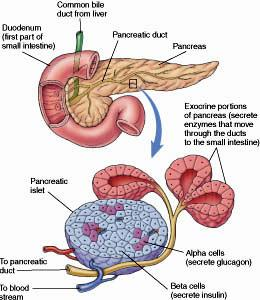
1909年De. Meyer给胰岛细胞激素起了一个名字—胰岛素(insulin),这个名字一直沿用到今天。可当时,这种激素的存在还只是一个假设。
1920年Banting 和 Macleod经过反复实验最终发现了胰岛素
Hormone and nutrient levels in the blood of healthy human subjects before and after a meal
Glucagon works with insulin to ensure stable levels of glucose in the blood. No other Hormone in the body can lower blood glucose levels, except insulin
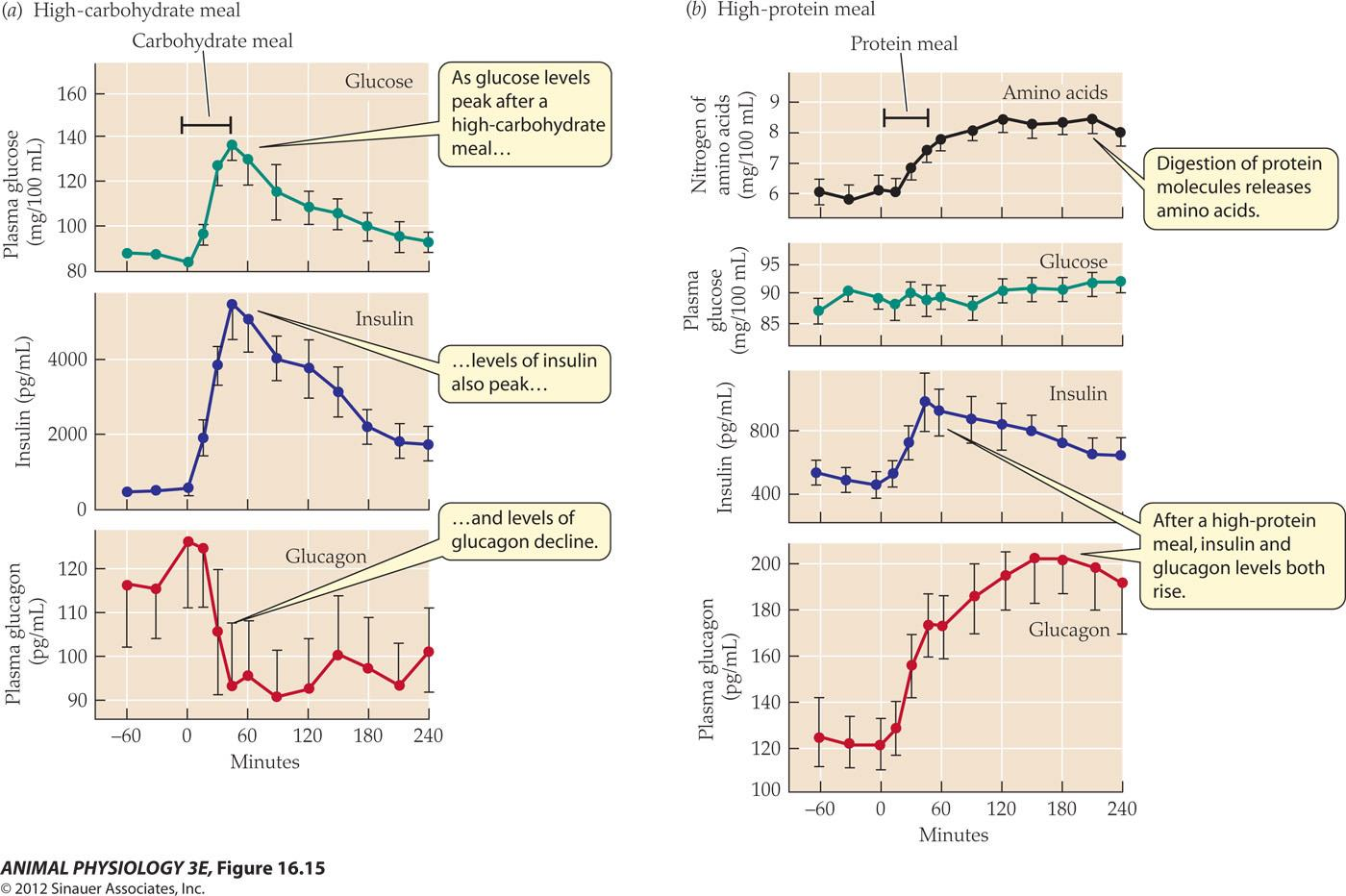
七、Endocrine Control of Calcium Metabolism in Mammals
Three hormones regulates extracellular calcium concentration:
- parathyroid hormone PTH
- Active vitamin D
- calcitonin 降钙素
Parathyroid hormone (PTH), active vitamin D, and calcitonin finely regulate Ca2+ in the extracellular fluid
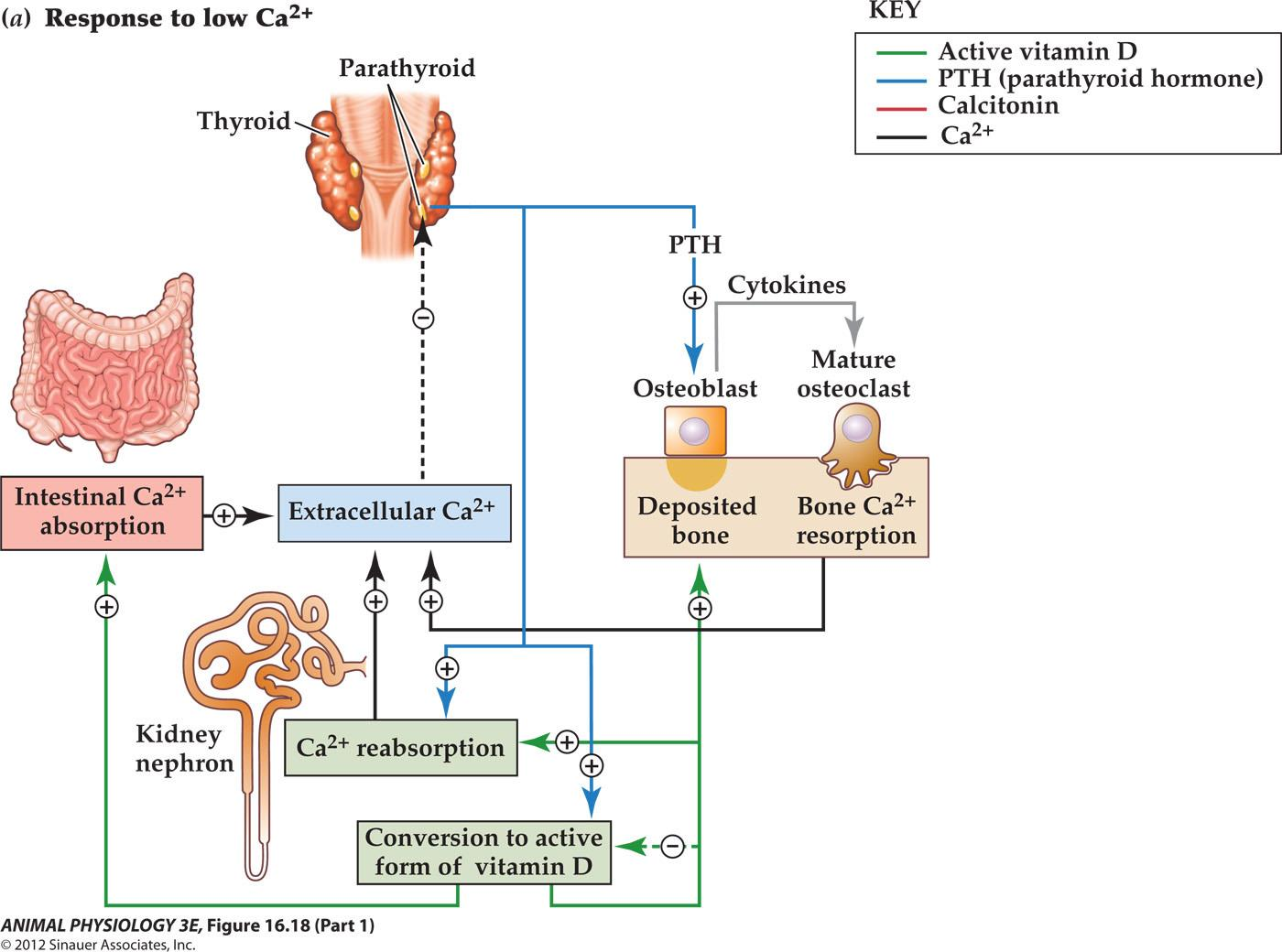
- Chief cells secretes PTH When extracellular Calcium s low
- Parathyroid hormone increases Ca2+ in the blood
- Active vitamin D increases Ca2+ and phosphate in the bloods
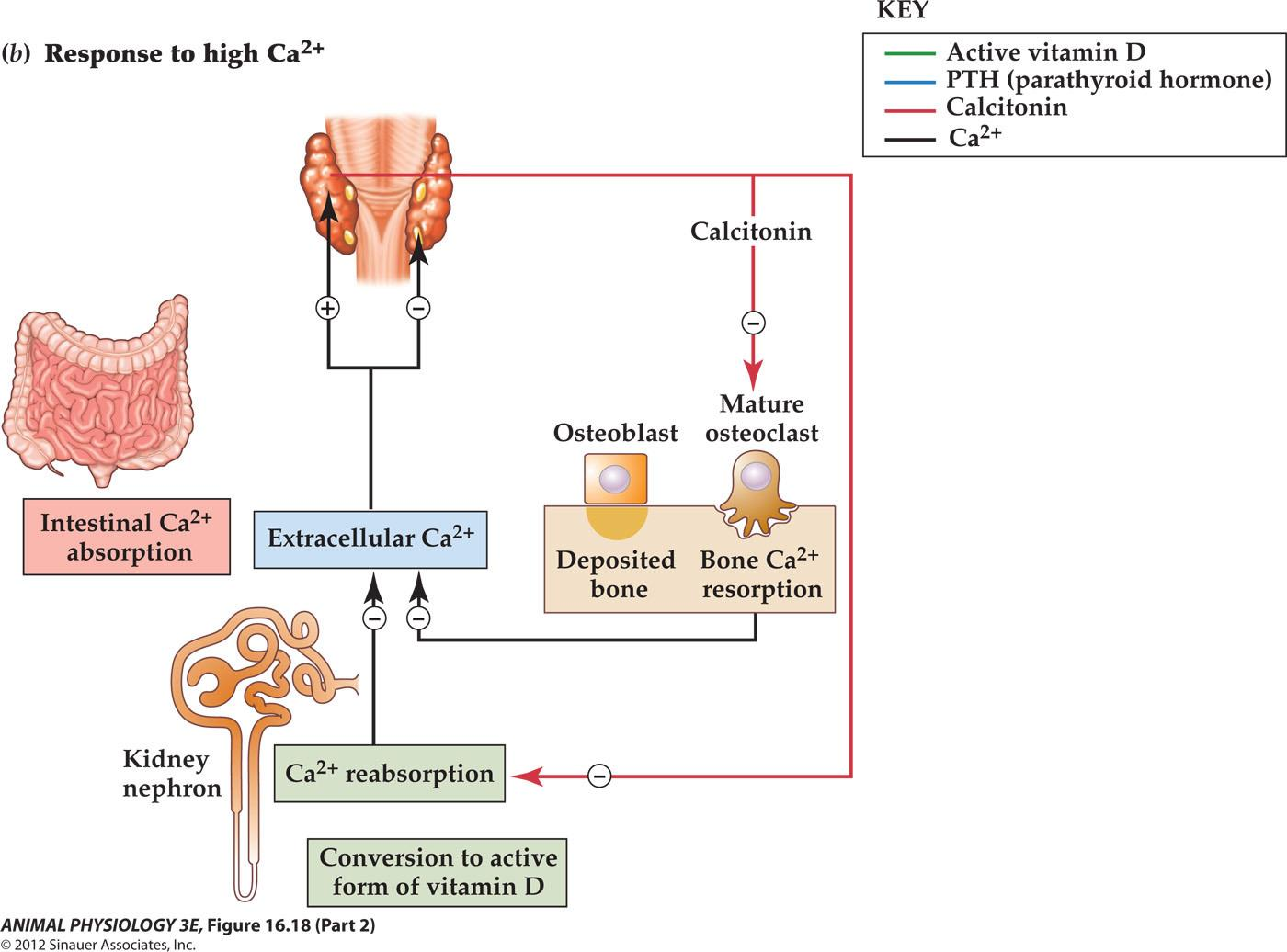
- Calcitonin opposes bone resorption and decreases Ca2+ and phosphate in the blood
Chemical messengers act over short, intermediate, and long distances
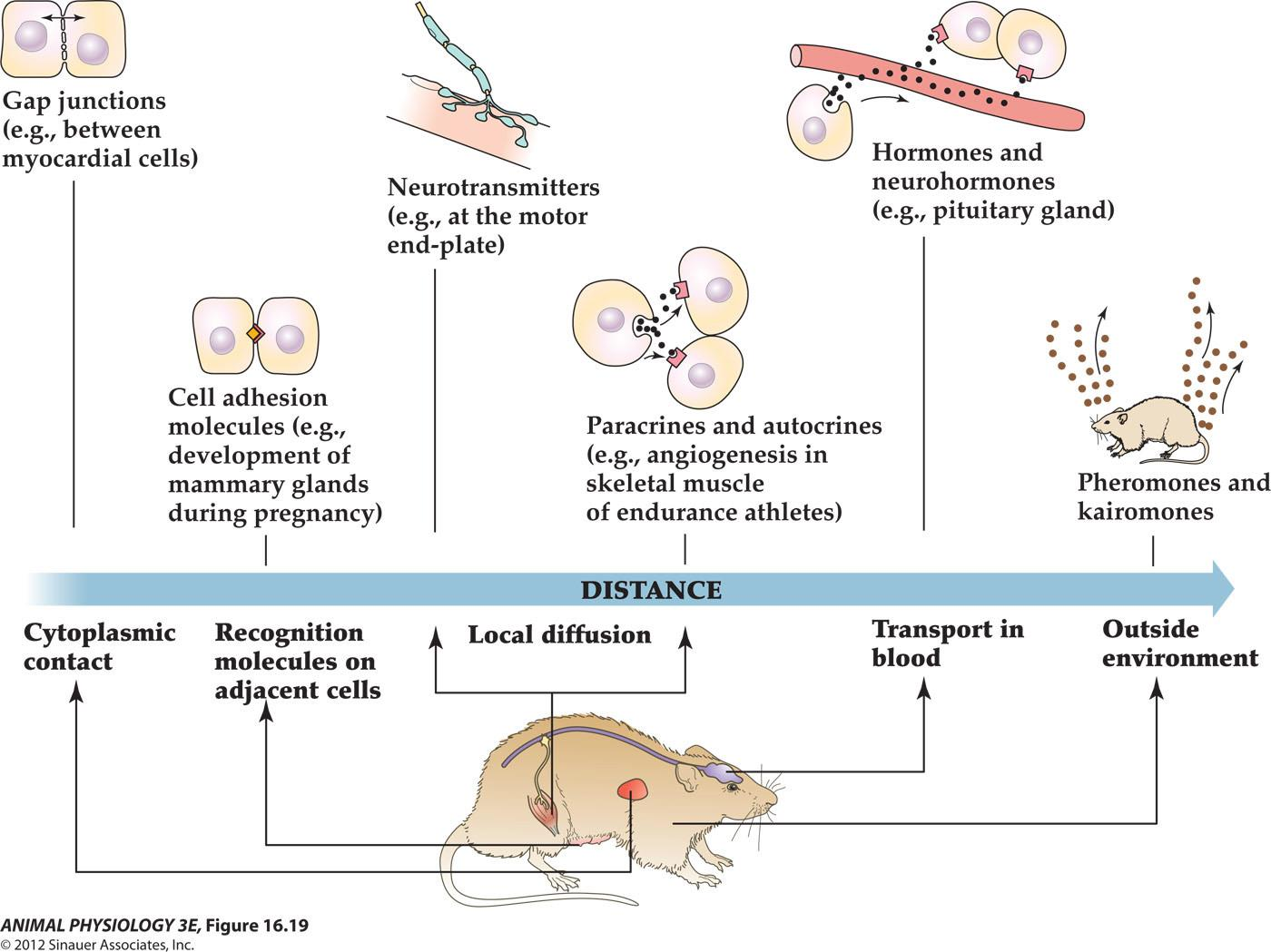
SUMMARY
Three hormones finely regulate the extracellular concentration of calcium ions in mammals: parathyroid hormone (PTH), active vitamin D (1,25-dihydroxycholecalciferol, or 1,25[OH]2D3), and calcitonin
The peptide PTH is secreted by chief cells of the parathyroid glands when extracellular Ca2+ is low. PTH stimulates cells in the nephron of the kidney to reabsorb Ca2+ and excrete phosphate and also to increase the conversion of inactive vitamin D to active vitamin D. In concert with active vitamin D, PTH stimulates bone resorption. These functions all contribute to increased Ca2+ in the extracellular fluid.
Active vitamin D is formed when extracellular Ca2+ is low. It is a steroid and binds to intracellular receptors to influence gene transcription in its target tissues. It promotes absorption of dietary Ca2+ across the intestinal epithelium, the resorption of bone, and the reabsorption of both Ca2+ and phosphate in the nephron. Its actions increase Ca2+ and phosphate in the extracellular fluid.
The peptide calcitonin targets osteoclasts in bone to inhibit bone resorption. At the kidney nephron, calcitonin increases the excretion of calcium and phosphate ions. These actions decrease calcium and phosphate in the extracellular fluid.